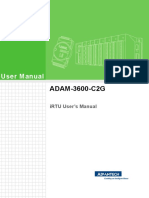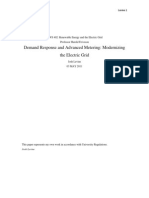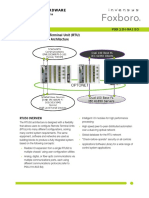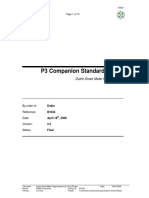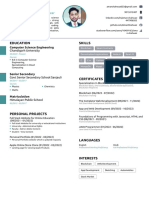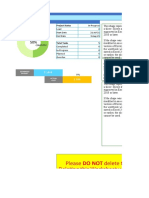Using Ti's Dlms Cosem Library
Uploaded by
hanspktUsing Ti's Dlms Cosem Library
Uploaded by
hanspktApplication Report
SLAA614 November 2013
Using TIs DLMS COSEM Library
Chander B Goel and Steve Underwood
ABSTRACT
This application report describes in detail the usage of DLMS COSEM library developed by Texas
Instruments for customers who use TIs microcontrollers in metering applications. The library is provided
as object coded with a configuration file for ease of use. The library can be obtained by contacting the
regional sales and marketing offices. The customer will have to sign an SLA before getting access to the
library.
Contents
1 Introduction .................................................................................................................. 1
2 Features ...................................................................................................................... 2
3 Prerequisites ................................................................................................................. 2
4 File Structure ................................................................................................................ 2
5 Object List Tables ........................................................................................................... 3
6 Attribute List Tables ........................................................................................................ 3
7 Handling of Complex Data Types Like Structures and Arrays Through ASN.1BER Encoding ................... 4
8 The Call Back Function .................................................................................................... 4
9 Handling of Multiple Entries in a Profile Generic Class Buffer ........................................................ 4
10 Changing the PDU Size .................................................................................................... 7
11 Methods List Tables and Method Description ........................................................................... 7
12 Handling Associations ...................................................................................................... 9
13 Adding a New Class ........................................................................................................ 9
14 Reference .................................................................................................................... 9
List of Figures
1 Object List Table ........................................................................................................... 3
2 Attribute List Table .......................................................................................................... 3
3 Method List Table ........................................................................................................... 7
1 Introduction
DLMS stands for Device Language Message specification. It is a generalized concept for abstract
modeling of communication entities which, along with the COSEM (COmpanion Specification for Energy
Metering) specification, has been standardized as a set of rules for data exchange with energy meters.
The DLMS specification is developed and maintained by the DLMS User Association and has been
adopted by the IEC TC13 WG14 into the IEC 62056 series of standards.
Texas Instruments has developed a compact and easy to use library that can be integrated into a
metering application on TIs MSP430 microcontrollers. Section 2 describes the various features of this
library.
IAR Embedded Workbench is a registered trademark of IAR Systems AB.
All other trademarks are the property of their respective owners.
SLAA614 November 2013 Using TIs DLMS COSEM Library 1
Submit Documentation Feedback
Copyright 2013, Texas Instruments Incorporated
Features www.ti.com
2 Features
The DLMS Library provided by Texas Instruments supports the following features:
All COSEM classes are supported. The examples of a few commonly used classes are given.
Supports three associations: No Security (NS), Low Security (LS) and High Security (HS). In the HS
association, a four step AES128 based authentication mechanism is used. These three associations
are also referred as Public Client (PC), Meter Reader (MR) and Utility Setting (US) associations,
respectively.
Supports long name addressing
Supports one, two and four byte addressing
Supports GET, SET, GET WITH BLOCK, SET WITH BLOCK, ACTION and Selective Access requests
A special mechanism for handling Profile Generic objects where multiple data entries are required
Supports selective access in Profile Generic Class Buffer
Passes all DLMS CTT V2.0 tests
Code Size - ~24KB
RAM Size ~ 1.8KB
Easy configuration and ease of use
3 Prerequisites
For using this library, it is required that you have a thorough understanding of DLMS Blue Book Classes
and embedded C programming background.
For any development on DLMS library, you need to have DLMS Client software so that the meter can be
tested. There are a few companies like Kalkitech, Gurux, and so forth that provide a semi-functional demo
software, which can be downloaded from the internet. For developing a final product, one would need to
buy a full version of the Kalkitech DLMS Client.
You also need to have a full version of IAR Embedded Workbench for MSP430.
4 File Structure
The following files are available in the library:
iec62056_demo.c: This is the user interface file for system initialization. All the peripherals are
initialized and the HDLC state machine is initialized.
uart_comms.c: This is the configuration file for the UART module. Depending upon the requirement,
the available USCIs can be initialized.
iec62056_link.r43: This file implements HDLC and Mac layer. This file is provided as object coded file.
server_msgs.r43: This file implements COSEM application layer. This file is also provided as object
coded file.
config.c: This file is the main configuration file for the users system. In this file, one can add or remove
parameters from the object list, which is described later in the document
app_server_msgs.c: This file is the one where most of the user code has to be written. Here, one has
to write all the functions, which are used to extract data from the memory and provide it to the DLMS
library.
config.h: Prototype declarations and macro definitions for config.c
cosem.h: Definition of all the constants used in COSEM application layer.
iec_62056_link.h:Prototype declarations and macro definitions for HDLC layer.
2 Using TIs DLMS COSEM Library SLAA614 November 2013
Submit Documentation Feedback
Copyright 2013, Texas Instruments Incorporated
www.ti.com Object List Tables
5 Object List Tables
The first step in starting to use the DLMS library is to add, remove or update the list of objects in the
object list table (see Figure 1). The object list table is defined in config.c file. They are defined as
object_desc_s data type. The different rows in the object list table represent different objects that the
meter supports. An object is the representation of a metering parameter or a data log.
const struct object_desc_s object_list_NS[] =
{ /*Mandatory objects */
{ASSOC_PC_MR, CLASS_ID_CLOCK, 0, { 0, 0, 1, 0, 0, 255}, 9, clock_attrs, 6, clock_methods},
Number of Attribute Number of Method List
Associations Class ID Version OBIS Code
Attributes List Pointer Methods Pointer
Figure 1. Object List Table
The following columns in the object list table appear in order:
Associations: The associations where this object is visible.
Class-ID: The class ID indicates which class does this object belongs to. This is an enumerated data
type and various classes names are available under macro-definition.
Class Version Number: This entry specifies the version number of a specific class type as per the
DLMS specification.
OBIS Code: This entry is the six character code for the parameter, which is referred in this row. The
OBIS codes for most of the common metering parameters are defined in the DLMS Blue Book 11th
Edition (section 6).
Number of Attributes: This entry indicates the number of attributes available for the parameter of this
specific class.
Attribute Table Pointer: Each parameter in the Object List Table has its own attribute list table. The
attribute list table is further defined in Section 6. This entry gives a pointer to the attribute list table for
the entry.
Number of Methods: This entry indicates the number of methods implemented for the parameters of
this specific class.
Method Table Pointer: Each parameter in the Object List Table has its own method list table. The
method list table is very similar to attribute list table and is further defined in Section 6. This entry gives
a pointer to the method list table for the entry.
6 Attribute List Tables
After adding the entry in the Object List Table, the next step is to build an attribute table (see Figure 2).
The attribute table has the following columns and the number of entries depends upon the type of class to
which the parameter in question belongs to.
static const struct attribute_desc_s Obj_I_R[] =
{ {1, ACCESS_PCR__MRR__USR_, TAG_OCTET_STRING, (void *) object_list_HS[21].instance_id, NULL},
Attribute Access Attribute Attribute Data Callback
Number Rights Datatype Pointer function
Figure 2. Attribute List Table
SLAA614 November 2013 Using TIs DLMS COSEM Library 3
Submit Documentation Feedback
Copyright 2013, Texas Instruments Incorporated
Handling of Complex Data Types Like Structures and Arrays Through ASN.1BER Encoding www.ti.com
Attribute Number: The first entry in this table indicates the serial number of the attribute of this class.
Access Rights: The second column provides the access rights for this attribute depending upon the
type of association that is established between DLMS server and client. The syntax for providing the
access rights is PCXY_MRXY_USXY, where PC, MR, US correspond to the type of association X is
R if a read access is available and _ if no read access is available. Similarly, Y is W if a write access is
available and _ if no write access is available.
Data Type: This column defines a TAG for the data type to which this parameter belongs. The DLMS
documentation (Blue Book, section 4.1.5) specifies a TAG for each data type. There are predefined
macros available for each data type.
Data Pointer: This value gives the pointer to the location where this value is stored.
Call Back Function: If this value is not readily available in the RAM, then the library calls this call-back
function that will execute some C code, which will fill up the actual value at the location specified in
column 4.
7 Handling of Complex Data Types Like Structures and Arrays Through ASN.1BER
Encoding
The DLMS objects require a special encoding of data, which is called ASN.1BER coding. The format of
ASN.1BER coding looks like this:
Tag_Int, Value
In case of character strings:
Tag_Octet_String, Length, char1, char2, char3etc.
In case of arrays and structures:
Tag_Structure,
Nb_of_Elements,
Tag_Element1, Value,
Tag_Element2, Value
Whenever, data is provided as constant, it has to be formatted in the same form as above. There is no
need to put the starting tag as it is taken from the Attribute List Table. But instead, you need to put the
total size of the definition string.
8 The Call Back Function
The call back function is needed when the MCU doesnt have the data requested by the DLMS client in its
RAM and this data has to be fetched from an external EEPROM or some other controller. If there is a call-
back function written in the Attribute-List Table then the library will call this function first before returning
the data pointed by the Data Pointer in the table. The function has to be defined in the following way:
void function_name(void *data, int direction)
where, data is the pointer to the location where data has to be put in case of read and from where data
has to be taken in case of write.
Direction is 0 if data has to be read and 1 if data has to be written. In case of multiple entry objects like
profile generic buffers, one needs to give further information in the call-back function. This will be
explained in Section 9.
9 Handling of Multiple Entries in a Profile Generic Class Buffer
In a Profile Generic Class, the Buffer attribute can have a very big data, which can be in the form of
multiple entries in the meter. An example of this is the last six month billing history. In this case, there will
be a number of parameters that the meter has to record for each month. This DLMS library supports a
unique way of handling this data based upon templates. As mentioned earlier in the document, the data in
DLMS is encoded in ASN.1, which adds certain overhead in the actual data. This extra data remains the
same for multiple entries of the record. Therefore, this data is not needed to be stored in the Flash /
EEEPROM multiple times. One can define a template for an entry where you put this redundant data like
ASN.1 tags.
4 Using TIs DLMS COSEM Library SLAA614 November 2013
Submit Documentation Feedback
Copyright 2013, Texas Instruments Incorporated
www.ti.com Handling of Multiple Entries in a Profile Generic Class Buffer
As an example, assume that one has to record the following data in your meter after every 15 minutes.
Parameter Datatype
Date and Time String
Current R Phase Unsigned Long
Current Y Phase Unsigned Long
Current B Phase Unsigned Long
Voltage R Phase Unsigned Integer
Voltage Y Phase Unsigned Integer
Voltage B Phase Unsigned Integer
Active Energy Unsigned Long
Reactive Energy - Lag Unsigned Long
Reactive Energy Lead Unsigned Long
Apparent Energy Unsigned Long
Assume that all currents are 10 Amps, Voltages 240 V and Energies as 100 KWh, then a single entry has
to be encoded in ASN.1 as follows:
TAG_STRUCTURE, 0x0b,
TAG_OCTET_STRING, 12, ITEM_TAG_DATETIME_LP, 0, 0, 0, 0, 0, 0, 0, 0, 0, 0, 0, /* Time
& Date */
TAG_UINT32, 0x00,0x00,0x03,0xe8 /* Ir =10.00 A*/
TAG_UINT32, 0x00,0x00,0x03,0xe8 /* Iy =10.00 A*/
TAG_UINT32, 0x00,0x00,0x03,0xe8 /* Ib =10.00A */
TAG_UINT16, 0x09,0x60, /* Vr=240.0V */
TAG_UINT16 ,0x09,0x60, /* Vy=240.0V */
TAG_UINT16, 0x09,0x60, /* Vb=240.0V */
TAG_UINT32, 0x00,0x00,0x27,0x10 /* Active Energy =100.00KWh*/
TAG_UINT320x00,0x00,0x27,0x10 /* Reactive Energy Lag=100.00KVarh */
TAG_UINT32, 0x00,0x00,0x27,0x10 /* Reactive Energy Lead=100.00KVarh */
TAG_UINT32, 0x00,0x00,0x27,0x10 /* Apparent Energy = 100KVAh*/
The ASN.1 encoding above indicates that it is a structure with 11 elements. The first element is an octet
string with 12 characters, the second element is a 32-bit unsigned long and so on. When the above data is
recorded after every 15 minutes for 10 days, there will be 960 entries of the data exemplified above. For
compacting the space required for such data, and for handling multiple entries easily, a template-based
mechanism was put into place. The following is an example of the template for the above data:
Example 1. Example of a Template
const uint8_t Load_Profile_Buffer_Template[] =
{
STUFF_DATA | TAG_STRUCTURE, 11,
STUFF_DATA | TAG_OCTET_STRING, 12, ITEM_TAG_DATETIME_LP, 0, 0, 0, 0, 0, 0, 0, 0, 0, 0, 0, /*
Time & Date */
STUFF_DATA | TAG_UINT32, INJECT32 (ITEM_TAG_IR_LP), /* Ir */
STUFF_DATA | TAG_UINT32, INJECT32 (ITEM_TAG_IY_LP), /* Iy */
STUFF_DATA | TAG_UINT32, INJECT32 (ITEM_TAG_IB_LP), /* Ib */
STUFF_DATA | TAG_UINT16, INJECT16 (ITEM_TAG_VR_LP), /* Vr */
STUFF_DATA | TAG_UINT16, INJECT16 (ITEM_TAG_VY_LP), /* Vy */
STUFF_DATA | TAG_UINT16, INJECT16 (ITEM_TAG_VB_LP), /* Vb */
STUFF_DATA | TAG_UINT32, INJECT32 (ITEM_TAG_CUM_KWH_TOTAL_LP), /* Active Energy */
STUFF_DATA | TAG_UINT32, INJECT32 (ITEM_TAG_CUM_KVAR_LAGH_TOTAL_LP), /* Reactive Energy -
Lag */
STUFF_DATA | TAG_UINT32, INJECT32 (ITEM_TAG_CUM_KVAR_LEADH_TOTAL_LP), /* Reactive Energy -
Lead */
STUFF_DATA | TAG_UINT32, INJECT32 (ITEM_TAG_CUM_KVAH_TOTAL_LP), /* Apparent Energy */
};
SLAA614 November 2013 Using TIs DLMS COSEM Library 5
Submit Documentation Feedback
Copyright 2013, Texas Instruments Incorporated
Handling of Multiple Entries in a Profile Generic Class Buffer www.ti.com
In the above template, INJECT32 is a macro, which converts a single long number into byte-wise
characters in the same endianness as per DLMS requirement. In place of the actual data, a user defined
lable is input ( ITEM_TAG_DATETIME above). This label is used as a pointer for the function
Get_Numeric_Item, Get_String_Item, Set_Numeric_Item & Set_String_Item (defined in file
app_server_msgs.c), which is explained in the subsequent section. Each separate parameter has to have
a unique label. Once the template is defined, the next step is to write the call-back function. When the call
back function is called from the library, it carries the Selective Access information in case the DLMS
client wants to read the selective data only. The Selective Access is not supported in case of the SET
command. This data is passed in the following library variables.
In case of Selective access by entry:
SA_From_Entry: This carries the number of the first entry, which the client wants to read.
SA_To_Entry: This carries the number of the last entry.
In case of selective access by range:
SA_Range[0] : This will have the date and time of the first entry, which the client wants to read.
SA_Range[1] : This will have the date and time of the last entry.
Based on the above selective access information and the predefined template, you need to initialize the
following msg_info data structure to pass the relevant information to the library. The following structure is
defined in the library, to which, you have to pass the values.
Example 2. The Msg_Info Data Structure
typedef struct
{
const uint8_t *template;
uint16_t sz_template;
uint16_t start_entry;
uint16_t num_entries;
uint16_t entries_remaining;
const uint16_t *column_szs;
} Msg_Info;
msg_info.template : This element points to the template defined for that particular object.
msg_info.sz_template: This is the size of the template that is explained earlier.
msg_info.start_entry: As there can be a number of entries that have to be transferred, this value
indicates the number of the entry from where to start.
msg_info.num_entries: This element has to be filled with the total number of entries that has to be
transferred.
msg_info.entries_remaining: This element is automatically updated in the library, which tells how many
entries data has been transferred.
msg_info.column_szs: This is an array of cumulative count of bytes in each column of the template.
This parameter is used by the library in case the client needs to apply selective access.
Once you have completed the above steps, then the last step is to insert some code in the function
get_numeric_item(), get_string_item(), set_numeric_item() or set_string_item() in the file
app_server_msgs.c.
These functions are called by the library when it is decoding the profile template and encounters
STUFF_DATA tag. In case of GET command, depending upon the data type of the parameter, either of
get_numeric item() or get_string_item() are called with the corresponding item tag as argument. In these
functions, you have to add a switch case statement and provide the required data into the val variable.
6 Using TIs DLMS COSEM Library SLAA614 November 2013
Submit Documentation Feedback
Copyright 2013, Texas Instruments Incorporated
www.ti.com Changing the PDU Size
The example below explains this in a better way.
int32_t get_numeric_item(int item)
{
int64_t val;
switch (item)
{
___________________
____________________
case ITEM_TAG_IR:
entry_no = msg_info.start_entry+(msg_info.num_entries-msg_info.entries_remaining);
val=read_EEPROM_param(Load_Param,entry_no,IR);
break;
____________________
____________________
}
}
In case of the SET command, again depending upon the data type of the parameter, either of
set_numeric_item() or set_string_item will be called with the data pointer from where data have to be
copied as an argument. The example below explains this in a better way.
void set_numeric_item(uint8_t item, uint8_t *data, uint16_t len)
{
switch(item)
{
________________________
________________________
case ITEM_TAG_DAY_PROFILE_SCRIPT_ID1:
entry_no = msg_info.start_entry+(msg_info.num_entries-msg_info.entries_remaining);
EEPROM_Write(ADDRESS_DAY_ID+entry_no,data)
break;
__________________________
__________________________
}
}
10 Changing the PDU Size
If there is a huge data to be transferred from the meter (server) to the client, then this data is broken into
small PDUs and then sent by a GET_NEXT_BLOCK mechanism. It is up to you to define the size of this
PDU. There is an environment variable defined by name CHUNK_SIZE, which can be used to change the
PDU size.
11 Methods List Tables and Method Description
The method list table is similar to the attribute list table. Figure 3 shows the meanings of different columns
in method list table.
static const struct method_desc_s Obj_Instant_Profile_Methods[] =
{
{1, ACCESS_PC___MR___USR_, Obj_Instant_Profile_reset},
Method Access
Method Function Pointer
Number Rights
Figure 3. Method List Table
Method Number: The first entry in this table indicates the serial number of the method of this class.
Access Rights: The second column provides the access rights for this method depending upon the
type of association that is established between DLMS server and client. The syntax for providing the
SLAA614 November 2013 Using TIs DLMS COSEM Library 7
Submit Documentation Feedback
Copyright 2013, Texas Instruments Incorporated
Methods List Tables and Method Description www.ti.com
access rights is PCXY_MRXY_USXY, where PC, MR, US correspond to the type of association X is
R if a read access is available and _ if no read access is available. Similarly, Y is W if a write access is
available and _ if no write access is available.
Method Function Pointer: This value gives a pointer to the C function that you need to execute in the
meter software. The functions have to be written with predefined arguments. Below is the syntax for
the function:
void Obj_Instant_Profile_reset(uint8_t *data,uint16_t data_len,uint8_t
*response,uint16_t *response_len)
{
// Your code comes here.
}
In the above function definition, data is the pointer to the data (if any) sent by the DLMS Client as
argument for this method, data_len carries the length of this data, response is the data that is to be
returned to the client and response_len is the length of this returned data.
8 Using TIs DLMS COSEM Library SLAA614 November 2013
Submit Documentation Feedback
Copyright 2013, Texas Instruments Incorporated
www.ti.com Handling Associations
12 Handling Associations
The DLMS library is configured to handle three associations. You do not have access to change the
properties of these associations, except the passwords. Table 1 describes the properties of these
associations:
Table 1. Handling Associations
Feature Public Client Meter Reader Utility Setting
SAP Address pair in format (16,1) (32,1) (48,1)
(Client,server)
Application Context Basic LN without ciphering LN without ciphering LN without ciphering
Security
Application Context- Advanced Not Applicable LN - Ciphered LN - Ciphered
Security
Signon Authentication Lowest Level Low Level (LLS) High Level (HLS)
Mechanism IEC 62056-53,
Clause 7.3.7.2
Services in Conformance Block Get, Get with Block transfer Get, Get with Block transfer, Get, Set,Action, Get and Set with
Selective Access Block transfer, Selective Access
OBIS Codes 0.0.40.0.1.255 0.0.40.0.2.255 0.0.40.0.3.255
13 Adding a New Class
Adding a new class in the library is a simple process. You need to add an entry in the Object List table
with the new Class ID, give all the details and create the Attribute list and method list table. You have to
strictly follow the Class details given in the Blue Book.
14 Reference
DLMS UA 1000-1 ed.11, 2013 Blue book, COSEM Identification System and Interface Classes
SLAA614 November 2013 Using TIs DLMS COSEM Library 9
Submit Documentation Feedback
Copyright 2013, Texas Instruments Incorporated
IMPORTANT NOTICE
Texas Instruments Incorporated and its subsidiaries (TI) reserve the right to make corrections, enhancements, improvements and other
changes to its semiconductor products and services per JESD46, latest issue, and to discontinue any product or service per JESD48, latest
issue. Buyers should obtain the latest relevant information before placing orders and should verify that such information is current and
complete. All semiconductor products (also referred to herein as components) are sold subject to TIs terms and conditions of sale
supplied at the time of order acknowledgment.
TI warrants performance of its components to the specifications applicable at the time of sale, in accordance with the warranty in TIs terms
and conditions of sale of semiconductor products. Testing and other quality control techniques are used to the extent TI deems necessary
to support this warranty. Except where mandated by applicable law, testing of all parameters of each component is not necessarily
performed.
TI assumes no liability for applications assistance or the design of Buyers products. Buyers are responsible for their products and
applications using TI components. To minimize the risks associated with Buyers products and applications, Buyers should provide
adequate design and operating safeguards.
TI does not warrant or represent that any license, either express or implied, is granted under any patent right, copyright, mask work right, or
other intellectual property right relating to any combination, machine, or process in which TI components or services are used. Information
published by TI regarding third-party products or services does not constitute a license to use such products or services or a warranty or
endorsement thereof. Use of such information may require a license from a third party under the patents or other intellectual property of the
third party, or a license from TI under the patents or other intellectual property of TI.
Reproduction of significant portions of TI information in TI data books or data sheets is permissible only if reproduction is without alteration
and is accompanied by all associated warranties, conditions, limitations, and notices. TI is not responsible or liable for such altered
documentation. Information of third parties may be subject to additional restrictions.
Resale of TI components or services with statements different from or beyond the parameters stated by TI for that component or service
voids all express and any implied warranties for the associated TI component or service and is an unfair and deceptive business practice.
TI is not responsible or liable for any such statements.
Buyer acknowledges and agrees that it is solely responsible for compliance with all legal, regulatory and safety-related requirements
concerning its products, and any use of TI components in its applications, notwithstanding any applications-related information or support
that may be provided by TI. Buyer represents and agrees that it has all the necessary expertise to create and implement safeguards which
anticipate dangerous consequences of failures, monitor failures and their consequences, lessen the likelihood of failures that might cause
harm and take appropriate remedial actions. Buyer will fully indemnify TI and its representatives against any damages arising out of the use
of any TI components in safety-critical applications.
In some cases, TI components may be promoted specifically to facilitate safety-related applications. With such components, TIs goal is to
help enable customers to design and create their own end-product solutions that meet applicable functional safety standards and
requirements. Nonetheless, such components are subject to these terms.
No TI components are authorized for use in FDA Class III (or similar life-critical medical equipment) unless authorized officers of the parties
have executed a special agreement specifically governing such use.
Only those TI components which TI has specifically designated as military grade or enhanced plastic are designed and intended for use in
military/aerospace applications or environments. Buyer acknowledges and agrees that any military or aerospace use of TI components
which have not been so designated is solely at the Buyer's risk, and that Buyer is solely responsible for compliance with all legal and
regulatory requirements in connection with such use.
TI has specifically designated certain components as meeting ISO/TS16949 requirements, mainly for automotive use. In any case of use of
non-designated products, TI will not be responsible for any failure to meet ISO/TS16949.
Products Applications
Audio www.ti.com/audio Automotive and Transportation www.ti.com/automotive
Amplifiers amplifier.ti.com Communications and Telecom www.ti.com/communications
Data Converters dataconverter.ti.com Computers and Peripherals www.ti.com/computers
DLP Products www.dlp.com Consumer Electronics www.ti.com/consumer-apps
DSP dsp.ti.com Energy and Lighting www.ti.com/energy
Clocks and Timers www.ti.com/clocks Industrial www.ti.com/industrial
Interface interface.ti.com Medical www.ti.com/medical
Logic logic.ti.com Security www.ti.com/security
Power Mgmt power.ti.com Space, Avionics and Defense www.ti.com/space-avionics-defense
Microcontrollers microcontroller.ti.com Video and Imaging www.ti.com/video
RFID www.ti-rfid.com
OMAP Applications Processors www.ti.com/omap TI E2E Community e2e.ti.com
Wireless Connectivity www.ti.com/wirelessconnectivity
Mailing Address: Texas Instruments, Post Office Box 655303, Dallas, Texas 75265
Copyright 2013, Texas Instruments Incorporated
You might also like
- TSM 1.0 - User Manual - Excerpt TERRANOVA Smart Metering LibrariesNo ratings yetTSM 1.0 - User Manual - Excerpt TERRANOVA Smart Metering Libraries37 pages
- Privacy-Preserving Aggregation and AuthenticationNo ratings yetPrivacy-Preserving Aggregation and Authentication14 pages
- JIO CCMS Based Feeder Monitoring and ControlNo ratings yetJIO CCMS Based Feeder Monitoring and Control11 pages
- Adam6300 User Manaul Ed2final-623b52efa2b97No ratings yetAdam6300 User Manaul Ed2final-623b52efa2b9788 pages
- WEG Sca06 Modbus Rtu Manual 10001625775 Manual EnglishNo ratings yetWEG Sca06 Modbus Rtu Manual 10001625775 Manual English25 pages
- FlexiMC - A Smart Way To Manage Your Solar AssetNo ratings yetFlexiMC - A Smart Way To Manage Your Solar Asset12 pages
- Demand Response and Advanced Metering: Modernizing The Electric GridNo ratings yetDemand Response and Advanced Metering: Modernizing The Electric Grid29 pages
- Electricity Theft Detection in AMI Based On Clustering and Local Outlier FactorNo ratings yetElectricity Theft Detection in AMI Based On Clustering and Local Outlier Factor10 pages
- RTU560-RTU211 - Solutions Overview - BrochureNo ratings yetRTU560-RTU211 - Solutions Overview - Brochure12 pages
- Electronics, Inc: DNP3 Server ConfigurationNo ratings yetElectronics, Inc: DNP3 Server Configuration11 pages
- Prepayment Metering System: by Amit Kumar GuptaNo ratings yetPrepayment Metering System: by Amit Kumar Gupta4 pages
- ADAM-5630 Series User Manual Ed.1.FINALNo ratings yetADAM-5630 Series User Manual Ed.1.FINAL30 pages
- 21h8a1b3 - RTU50 SCADA RTU ArchitectureNo ratings yet21h8a1b3 - RTU50 SCADA RTU Architecture12 pages
- Installation, Testing &integration of New Remote Telemetry Unit (RTU) For Water SCADA System Requirements & Specifications0% (1)Installation, Testing &integration of New Remote Telemetry Unit (RTU) For Water SCADA System Requirements & Specifications35 pages
- ICP DAS WISE User Manual - V1.1.1en - 52xxNo ratings yetICP DAS WISE User Manual - V1.1.1en - 52xx288 pages
- Adam 3600 C2G - DS (121820) 20201221105950No ratings yetAdam 3600 C2G - DS (121820) 202012211059502 pages
- SE-S856-MSS - Easergy Builder - User Manual - EN - 4.0No ratings yetSE-S856-MSS - Easergy Builder - User Manual - EN - 4.0146 pages
- Features: Intel Pentium M Processor, 915GME/910GMLE ETX CPU ModuleNo ratings yetFeatures: Intel Pentium M Processor, 915GME/910GMLE ETX CPU Module3 pages
- GW-7228 J1939 To Modbus RTU Gateway Quick Start Guide: Appearance and Pin AssignmentsNo ratings yetGW-7228 J1939 To Modbus RTU Gateway Quick Start Guide: Appearance and Pin Assignments9 pages
- Quectel BG95BG77BG600L Series QCFG at Commands Manual V1.0No ratings yetQuectel BG95BG77BG600L Series QCFG at Commands Manual V1.042 pages
- RS09F004 SaturneMSAPITechnicalSpecificationNo ratings yetRS09F004 SaturneMSAPITechnicalSpecification55 pages
- Implementing A Microgrid Using Standard Utility Control EquipmentNo ratings yetImplementing A Microgrid Using Standard Utility Control Equipment11 pages
- Detect Nontechnical Loss Accurately and Efficiently To Reduce Energy TheftNo ratings yetDetect Nontechnical Loss Accurately and Efficiently To Reduce Energy Theft2 pages
- Accenture Smart Metering Report Digitally Enabled Grid PDFNo ratings yetAccenture Smart Metering Report Digitally Enabled Grid PDF24 pages
- Kalkitech - Meter Data Management SystemNo ratings yetKalkitech - Meter Data Management System5 pages
- Dutch Smart Meter Requirements v2.2 Final P3No ratings yetDutch Smart Meter Requirements v2.2 Final P373 pages
- Integration of Demand Response into the Electricity Chain: Challenges, Opportunities, and Smart Grid SolutionsFrom EverandIntegration of Demand Response into the Electricity Chain: Challenges, Opportunities, and Smart Grid SolutionsNo ratings yet
- (Excerpts From) Investigating Performance: Design and Outcomes With XapiFrom Everand(Excerpts From) Investigating Performance: Design and Outcomes With XapiNo ratings yet
- Srikanth Karanam FlowCV Resume 20241226 (3)No ratings yetSrikanth Karanam FlowCV Resume 20241226 (3)1 page
- Building An Online Bidding Application Using PHP50% (2)Building An Online Bidding Application Using PHP110 pages
- Travelogue A Travel Application Using MERN and Augmented RealityNo ratings yetTravelogue A Travel Application Using MERN and Augmented Reality8 pages
- Please DO NOT Delete This Worksheet. Deleting This Worksheet Will Result in ErrorsNo ratings yetPlease DO NOT Delete This Worksheet. Deleting This Worksheet Will Result in Errors9 pages
- GCP DevOps - Interview Preparation GuideNo ratings yetGCP DevOps - Interview Preparation Guide10 pages
- Week 2 Programming Concepts and Logic Formulation: CC102 Fundamentals of ProgrammingNo ratings yetWeek 2 Programming Concepts and Logic Formulation: CC102 Fundamentals of Programming53 pages
- TSM 1.0 - User Manual - Excerpt TERRANOVA Smart Metering LibrariesTSM 1.0 - User Manual - Excerpt TERRANOVA Smart Metering Libraries
- WEG Sca06 Modbus Rtu Manual 10001625775 Manual EnglishWEG Sca06 Modbus Rtu Manual 10001625775 Manual English
- Demand Response and Advanced Metering: Modernizing The Electric GridDemand Response and Advanced Metering: Modernizing The Electric Grid
- Electricity Theft Detection in AMI Based On Clustering and Local Outlier FactorElectricity Theft Detection in AMI Based On Clustering and Local Outlier Factor
- Installation, Testing &integration of New Remote Telemetry Unit (RTU) For Water SCADA System Requirements & SpecificationsInstallation, Testing &integration of New Remote Telemetry Unit (RTU) For Water SCADA System Requirements & Specifications
- SE-S856-MSS - Easergy Builder - User Manual - EN - 4.0SE-S856-MSS - Easergy Builder - User Manual - EN - 4.0
- Features: Intel Pentium M Processor, 915GME/910GMLE ETX CPU ModuleFeatures: Intel Pentium M Processor, 915GME/910GMLE ETX CPU Module
- GW-7228 J1939 To Modbus RTU Gateway Quick Start Guide: Appearance and Pin AssignmentsGW-7228 J1939 To Modbus RTU Gateway Quick Start Guide: Appearance and Pin Assignments
- Quectel BG95BG77BG600L Series QCFG at Commands Manual V1.0Quectel BG95BG77BG600L Series QCFG at Commands Manual V1.0
- Implementing A Microgrid Using Standard Utility Control EquipmentImplementing A Microgrid Using Standard Utility Control Equipment
- Detect Nontechnical Loss Accurately and Efficiently To Reduce Energy TheftDetect Nontechnical Loss Accurately and Efficiently To Reduce Energy Theft
- Accenture Smart Metering Report Digitally Enabled Grid PDFAccenture Smart Metering Report Digitally Enabled Grid PDF
- Integration of Demand Response into the Electricity Chain: Challenges, Opportunities, and Smart Grid SolutionsFrom EverandIntegration of Demand Response into the Electricity Chain: Challenges, Opportunities, and Smart Grid Solutions
- (Excerpts From) Investigating Performance: Design and Outcomes With XapiFrom Everand(Excerpts From) Investigating Performance: Design and Outcomes With Xapi
- Travelogue A Travel Application Using MERN and Augmented RealityTravelogue A Travel Application Using MERN and Augmented Reality
- Please DO NOT Delete This Worksheet. Deleting This Worksheet Will Result in ErrorsPlease DO NOT Delete This Worksheet. Deleting This Worksheet Will Result in Errors
- Week 2 Programming Concepts and Logic Formulation: CC102 Fundamentals of ProgrammingWeek 2 Programming Concepts and Logic Formulation: CC102 Fundamentals of Programming






